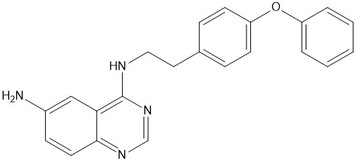QNZ | NFkB inhibitor / Store operated calcium entry
NMR (Conforms)

Available Options
| Size: | Price | Quantity | |
|---|---|---|---|
| 5 mg | $60.00 | ||
| 25 mg | $205.00 |
QNZ (545380-34-5) was originally described as a potent inhibitor of NF-κB activation (IC50 = 11 nM) and TNF-α production (IC50 = 7 nM).1,2 It indirectly inhibits the NF-κB pathway via inhibition of store-operated calcium entry (SOC) and displayed neuroprotective effects in transgenic fly and mouse models of Huntington’s disease.3,4 Its target has been postulated to be heteromeric calcium channels containing TRPC1 as one of the subunits.4 QNZ reduced synaptic neuronal SOC and rescued dendritic spine loss in YAC128 striatal medium spiny neurons.5 QNZ has also been identified as a potent (IC50 = 25 nM complex 1 from Y.lipolytica; IC50 = 14 nM complex 1 from Bos Taurus heart mitochondria) and selective inhibitor of mitochondrial complex I.6 QNZ decreased PSEN1ΔE9-mediated nSOCE upregulation and rescued mushroom spines in PSEN1ΔE9-expressing neurons, which are linked to familial Alzheimer’s disease.7
References/Citations:
1) Tobe et al. (2003), Discovery of quinazolines as a novel structural class of potent inhibitors of NF-kappa B activation; Bioorg. Med. Chem. Lett, 11 383
2) Tobe et al. (2003), A novel structural class of potent inhibitors of NF-kB activation: structure-activity relationships and biological effects of 6-aminoquinazoline derivatives; Bioorg. Med. Chem. Lett, 11 3869
3) Choi et al. (2006), Nuclear factor-kappaB activated by capacitive Ca2+ entry enhances muscarinic receptor-mediated soluble amyloid precursor protein (sAPPalpha) release in SH-SY5Y cells; J. Biol. Chem., 281 12722
4) Wu et al. (2011), Neuronal Store-Operated Calcium Entry Pathway as a Novel Therapeutic Target for Huntington’s Disease Treatment; Chem. Biol., 18 777
5) Wu et al. (2016), Enhanced Store-Operated Calcium Entry Leads to Striatal Synaptic Loss in a Huntington’s Disease Mouse Model; J. Neurosci., 36 125
6) Krishnathas et al. (2017), Identification of 4-N-[2-(4-phenoxyphenyl)ethyl]quinazoline-4,6-diamine as a novel, highly potent and specific inhibitor of mitochondrial complex I; Medchemcomm. 8 657
7) Chernyuk et al. (2019), Antagonist of neuronal store-operated calcium entry exerts beneficial effects in neurons expressing PSEN1∆E9 mutant linked to familial Alzheimer disease; Neuroscience, 410 118
NMR (Conforms)
Safety Data Sheet:
Product Data Sheet:
Materials provided by Focus Biomolecules are for laboratory research use only and are not intended for human or veterinary applications. Please note that we do not sell to individuals and that all orders placed by non-research organizations will incur a $20 restocking/refund fee
QNZ (545380-34-5) was originally described as a potent inhibitor of NF-κB activation (IC50 = 11 nM) and TNF-α production (IC50 = 7 nM).1,2 It indirectly inhibits the NF-κB pathway via inhibition of store-operated calcium entry (SOC) and displayed neuroprotective effects in transgenic fly and mouse models of Huntington’s disease.3,4 Its target has been postulated to be heteromeric calcium channels containing TRPC1 as one of the subunits.4 QNZ reduced synaptic neuronal SOC and rescued dendritic spine loss in YAC128 striatal medium spiny neurons.5 QNZ has also been identified as a potent (IC50 = 25 nM complex 1 from Y.lipolytica; IC50 = 14 nM complex 1 from Bos Taurus heart mitochondria) and selective inhibitor of mitochondrial complex I.6 QNZ decreased PSEN1ΔE9-mediated nSOCE upregulation and rescued mushroom spines in PSEN1ΔE9-expressing neurons, which are linked to familial Alzheimer’s disease.7
References/Citations:
1) Tobe et al. (2003), Discovery of quinazolines as a novel structural class of potent inhibitors of NF-kappa B activation; Bioorg. Med. Chem. Lett, 11 383
2) Tobe et al. (2003), A novel structural class of potent inhibitors of NF-kB activation: structure-activity relationships and biological effects of 6-aminoquinazoline derivatives; Bioorg. Med. Chem. Lett, 11 3869
3) Choi et al. (2006), Nuclear factor-kappaB activated by capacitive Ca2+ entry enhances muscarinic receptor-mediated soluble amyloid precursor protein (sAPPalpha) release in SH-SY5Y cells; J. Biol. Chem., 281 12722
4) Wu et al. (2011), Neuronal Store-Operated Calcium Entry Pathway as a Novel Therapeutic Target for Huntington’s Disease Treatment; Chem. Biol., 18 777
5) Wu et al. (2016), Enhanced Store-Operated Calcium Entry Leads to Striatal Synaptic Loss in a Huntington’s Disease Mouse Model; J. Neurosci., 36 125
6) Krishnathas et al. (2017), Identification of 4-N-[2-(4-phenoxyphenyl)ethyl]quinazoline-4,6-diamine as a novel, highly potent and specific inhibitor of mitochondrial complex I; Medchemcomm. 8 657
7) Chernyuk et al. (2019), Antagonist of neuronal store-operated calcium entry exerts beneficial effects in neurons expressing PSEN1∆E9 mutant linked to familial Alzheimer disease; Neuroscience, 410 118
Calculate the molar concentration, mass or volume in a solution.
Concentration × Volume × Molecular Weight = Mass
Focus Biomolecules • Plymouth Meeting, PA USA • 1-855-FOCUS21
Focus Biomolecules
Plymouth Meeting, PA USA
1-855-FOCUS21
Website Created by Advanta Advertising LLC.

